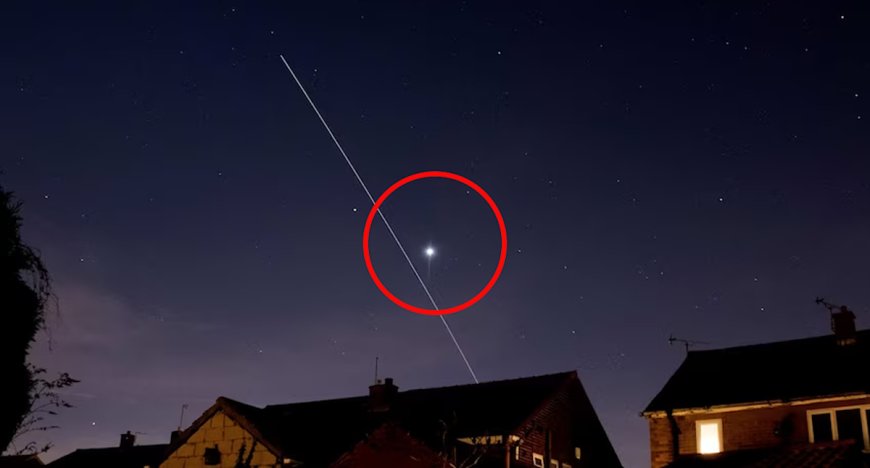How to See the 'Extremely Bright' International Space Station Over Australia This Week
Astronomy enthusiasts in Australia have a unique opportunity to witness the International Space Station (ISS) passing over the country during twilight hours. The ISS will appear as a bright, fast-moving white dot in the sky, visible with the naked eye. Find out the specific viewing times for Perth and how to spot this impressive sight.

The International Space Station will be orbiting above Australia this week. Here's how to see it.
Astronomy enthusiasts have an extraordinary chance to catch a glimpse of the International Space Station (ISS) this week as it passes over the country during twilight hours.
The 500-ton space laboratory, which orbits Earth, will appear as a bright, fast-moving white dot gliding smoothly across the sky and is viewable with the naked eye, no telescope needed. At its brightest, it can outshine Venus, making it an impressive and easy-to-spot sight.
This week, it will be visible in Perth on Tuesday at 6:25 pm, Wednesday at 7.12 pm, and Thursday at 6.24 pm, the Perth Observatory stated online on Monday, sparking excitement among locals. Speaking to Yahoo News, the Observatory's Tour Administrator Matt Woods said that over Perth, there are \"good\" ISS sightings every couple of weeks.
\"Extremely bright evening passes like this often come in clusters over two to three nights — sometimes you’ll get several in both the evening and early morning in the same week,\" he said.
\"This is usually followed by a quieter stretch where we don’t see the ISS at night because it's flying over Perth during the day instead. The timing and brightness of each pass depend on the station’s orbit and the position of the Sun relative to your location.
\"These passes occur during what we often refer to as the golden window, which is roughly the hour and a half after sunset or before sunrise. During this time, the sky is dark enough for us to see satellites, but they’re still high enough to catch sunlight before entering the Earth's Shadow. The ISS reflects this sunlight, making it appear as a bright, fast-moving 'star' in the sky.\"
Matt said a fun way to understand is to watch the sun set from ground level, then take a lift to the top of a tall building. \"You’ll see the sun 'set again' because you’ve gained enough height to catch those last rays, just like the ISS does as it orbits above us,\" he explained.
\"The ISS orbits at an average altitude of about 408 kilometres and takes roughly 90 minutes to complete one orbit around Earth. Its orbital path is tilted at 51.6 degrees to the equator, allowing it to pass over around 90p per cent of the world’s inhabited land, which is why so many people across the globe can catch a glimpse of it.\"
To view the ISS, you simply look up at the sky during its scheduled flyover time. Australians can find the schedule relevant to their location by searching their city here.
\"Give your eyes a few minutes to adjust to the dark and look in the right direction,\" Matt said. \"The ISS usually appears low on the horizon and moves steadily across the sky — apps will show you whether it’ll appear in the northwest, for example, and travel southeast.\"
The ISS orbits Earth about 16 times a day, but it's only visible at twilight, when it's illuminated by the Sun while the ground is dark.
The ISS has been continuously occupied by astronauts and cosmonauts since 2000.
The ISS is only visible when three things align
It’s flying over or near your location (which happens several times a day due to its orbit). It’s dark enough where you are to see it, usually within about one to hours hours after sunset or before sunrise. The ISS is still in sunlight, meaning it’s high enough above Earth that it’s catching sunlight while your location is in twilight or darkness.
What is the International Space Station used for?
The ISS is a 500-ton space laboratory orbiting Earth at 28,000 km/h, carrying astronauts and science experiments. Depending on location and timing, most Aussies can expect to see it once or twice a week.
The International Space Station (ISS) is permanently crewed as it orbits about 400 km above Earth. It was launched as a global science and engineering project to support long-term human presence in space and advance research that benefits life on Earth and future space exploration.
Construction of the ISS began in 1998, with the first module launched by Russia. It has been continuously occupied by astronauts and cosmonauts since 2000. Onboard, the ISS is used for a wide range of scientific research, including testing technologies for future missions to the Moon and Mars.
According to the source: Yahoo.
What's Your Reaction?
 Like
0
Like
0
 Dislike
0
Dislike
0
 Love
0
Love
0
 Funny
0
Funny
0
 Angry
0
Angry
0
 Sad
0
Sad
0
 Wow
0
Wow
0
















































































































































